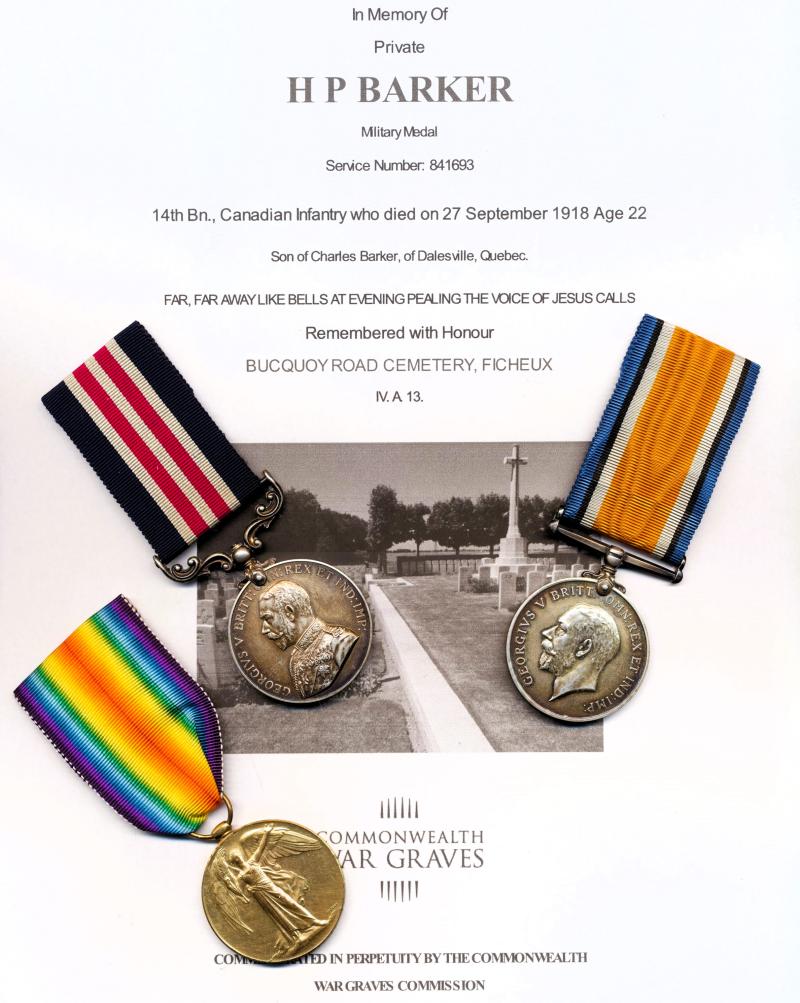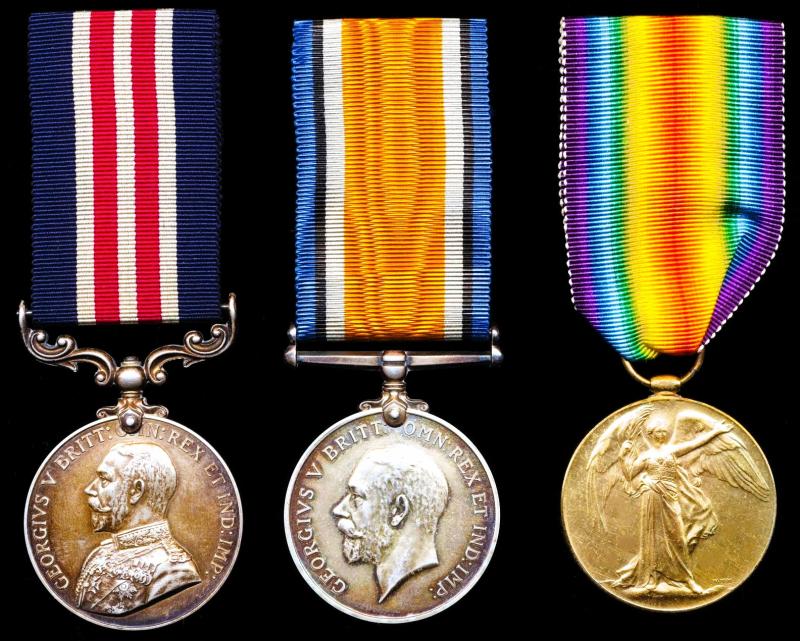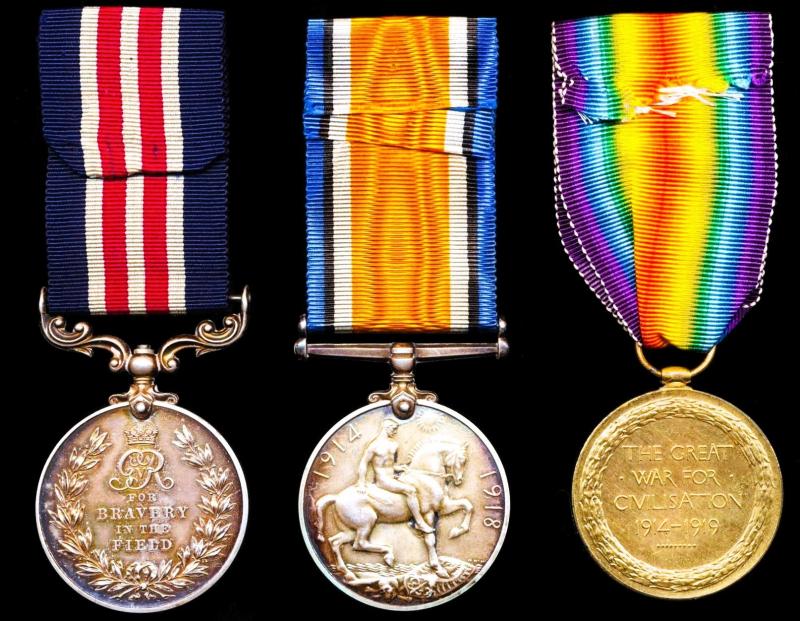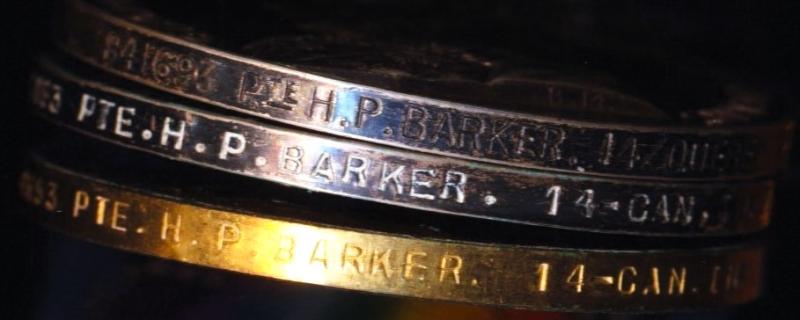A Canadian 'Posthumous' 'Cagnicourt / Buissey Switch' Military Medal & campaign medal group of 3: Private Hubert Peter Barker, 14th Battalion Canadian Expeditionary Force, att'd 2nd Canadian Tunnelling Company, late 148th "Overseas" Bn C.E.F.
- Military Medal. GV first type (841693 Pte H. P. Barker. 14/Quebec R.)
- British War Medal. Silver issue (841693 Pte. H. P. Barker. 14-Can. Inf.)
- Interallied Victory Medal (841693 Pte. H. P. Barker. 14-Can. Inf.)
Attached 2nd Canadian Tunnelling Company: Private Barker is confirmed 'attached' to 2nd Canadian Tunnelling Company 12 February - 6 August 1917 (recipients service papers refer). The unit as one of 3 x Canadian Tunneling Companies raised during the Great War. During his attachment, Hubert was deployed in the Tor Top, Armagh Wood and St Eloi are of operations on the Western Front, and took part in the preparations preceding, and was subsequently present throughout the Battle of Messines in June 1917. As part of the preparations for the Battle of Messines in June 1917, the 2nd Canadian Tunnelling Company began work on deep dugouts in the Ypres Salient. The Battle of Messines was a prelude to the much larger Third Battle of Ypres (31 July–10 November 1917). The underground building activities of the Royal Engineer units consisted of a series of deep mines dug by the British 171st, 175th, 250th, 1st Canadian, 3rd Canadian and 1st Australian Tunnelling companies to be fired at the start of the Battle of Messines (7–14 June 1917), while the British 183rd, 2nd Canadian and 2nd Australian Tunnelling companies built underground shelters in the Second Army area.The mines at Messines were detonated on 7 June 1917, creating 19 large craters
Wounded & Poisoned by Gas Shell: Private Hubert Barker is confirmed 'Wounded-in-Action' in France on, by a 'Gas Shell', on, 21 September 1917
Died-of-Wounds: Private Hubert Peter Barker, 14th Battalion Canadian Expeditionary Force is confirmed as having 'Died-of-Wounds' received in action in France, on, 27 September 1918
Military Medal: An award for 'France' that was published 'Posthumously' in the London Gazette issue of 11 February 1919
Bravery during the Battle of the Drocourt-Queant Line: In the location of the fighting at Cagnicourt / Buissy Switch, 2 September 1918, reference the regimental History of the 'Royal Montreal Regiment, 14th Battalion. C.E.F., 1914-25 (R. E. Fetherstonhaugh, 1927)', the recipient is included in a list of 16 'Other Ranks' of the 14/CEF whose names were recommended to the Commanding Officer for 'Bravery'
14/CEF 'Most Decorated Soldier': Lieutenant George P. McKean, V.C., M.C., M.M., fought in his last action of the Great War at, Cagnicourt, France, on, 2 September 1918. While in charge of the battalion's 'Scouts' and already the holder of the Victoria Cross and Military Medal, Lieutenant McKean was further decorated with the Military Cross for his conspicuous gallantry at Cagnicourt, during which action he and his tiny band of men 'liberated' the remnants of the village of Cagnicourt.
Quote (courtesy of Royal Montreal Regiment Foundation website, https://royalmontrealregiment.com/)
On the morning of September 2nd 1918 at 0500 hours, the assault on the Drocourt-Quéant line was launched by the Canadian Corps. At 0800 hours of the same morning, a scouting party of the Royal Montreal Regiment led by Lieutenant McKean, arrived at the outskirts of the French town of Cagnicourt. Most of the assault had either been killed or wounded during the advance and McKean, himself injured by shrapnel in his right leg from a 5.9inch shell, was accompanied by the few remaining men of the regiment. The village was occupied by several hundred Germans, but for McKean, who had already been awarded the Military Medal and the Victoria Cross for previous actions, this mattered little. Indeed, with fewer than 10 men, he led the charge on the village, shooting surprised Germans and gesturing to non-existing units on either side of him. The Germans, believing they had been outflanked and outmanoeuvered, surrendered to McKean and his handful of men. As they came out of their reinforced positions, they were shocked to see that they had been captured by only a handful of Canadian soldiers. For his actions, McKean was awarded the Military Cross. Due to the injury he suffered to his leg, McKean would be removed from combat until the end of the war.
Unquote.
Medals verification: All medals verified as entitled per respective dates of service shown in the recipients 'Service Papers' (held and accessible a the National Archives of Canada). Cut and paste below link into google search for the respective service file:
https://central.bac-lac.gc.ca/.item/?op=pdf&app=CEF&id=B0432-S056
Hubert Peter Barker, son of Charles William Barker (a 'Farmer' of English ethnicity) & Jane Barker (nee Cruise, of Irish ethnicity) was a native of, Dalesville, County Argentuil, Quebec Province, Canada, where he was born on, 25 November 1895. At the time of the 1911 National Census for Canada, Hubert was recorded as being employed as a 'Labourer' (agricultural) residing at the family farm, together with 4 x siblings, comprising an elder brother and 3 x younger sisters. On 5 March 1916, and then described as a 'farmer', Hubert enlisted in the Canadian Expeditionary Force, being posted to the 148th "Overseas" Battalion C.E.F.. On, 27 September 1916, Hubert embarked at Halifax, Nova Scotia, for overseas service with his battalion. After a voyage of just over 9 days, he disembarked at, Liverpool, England, on, 6 October 1916. On, 13 December 1916, he was posted to the 14th Battalion (Royal Montreal / Quebec Regiment), and first entered theatre of war 'France' on, 14 December 1916. In September 1917, he was 'Wounded' suffering from gas-poisoning after he had been 'Gassed' by a gas-shell, being admitted to the, 6th Casualty Clearing Station, on, 21 September 1917. After recovery in England, from his 'Gassing', Hubert was returned to his battalion in France, taking part in the fierce fighting on the Western Front, where during 'Canada's 100 Days' campaign, he was mortally wounded on, 27 September 1918. his medical records showing that he was admitted to the 33rd Casualty Clearing Station on that date suffering from 'Gunshot & Shrapnel Wound' to his left thigh, and having a compound fracture of the femur. Sadly at the time he was admitted to the 33rd Caualty Clearing Station, he was found to be already dead. The award of the Military Medal 'For Bravery in the Field', at in 1918, was awarded posthumously, being published in the London Gazette on 11 February 1919. Hubert's MM and campaign medals were sent to his nominated next of kin, his sister, Miss Susie Barker, while the Memorial Plaque is recorded as being sent to his father (his mother had died in 1914).
The life and supreme sacrifice of Private Hubert Peter Barker, is commemorated in perpetuity by the Commonwealth War Graves Commission at the Bucquoy Road Cemetery, Ficheux, France - a cemetery that contains the final resting places of many soldiers who died during the prolonged fighting near Arras 1916-1918 and where his body was laid to rest, and where his memorial flagstone is engraved with the post nominal letters 'M.M.', with the epitaph inscription tendered by his sister Emily:
Quote,
Far, Far Away Like Bells at Evening Pealing, the Voice of Jesus Calls
Unquote.
The history, honours and traditions of the 14th Battalion Canadian Expeditionary Force are perpetuated by the Royal Montreal Regiment of the Canadian Army
Each of the medals retaining their original silk 'moire' ribands
A choice grouping, the Interallied Victory Medal with pristine unblemished gilt finish as issued
Condition: Silver medals toned EF
Code: 23635






